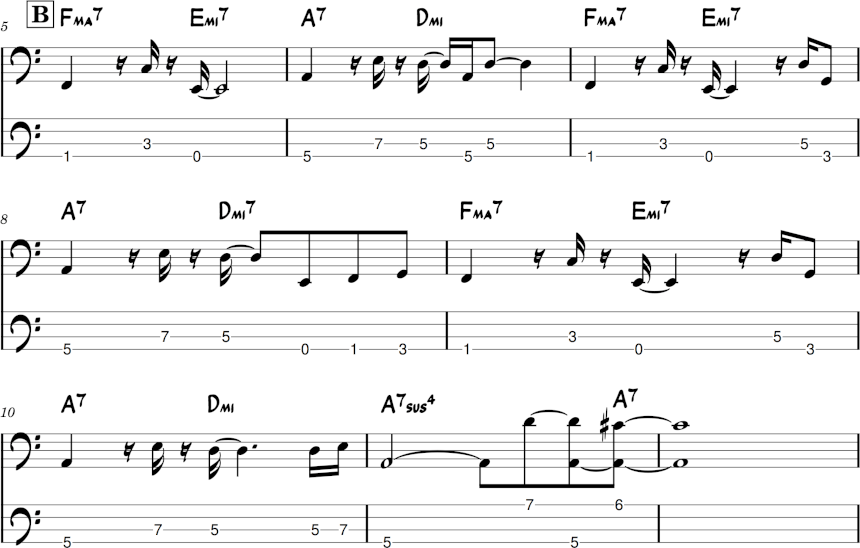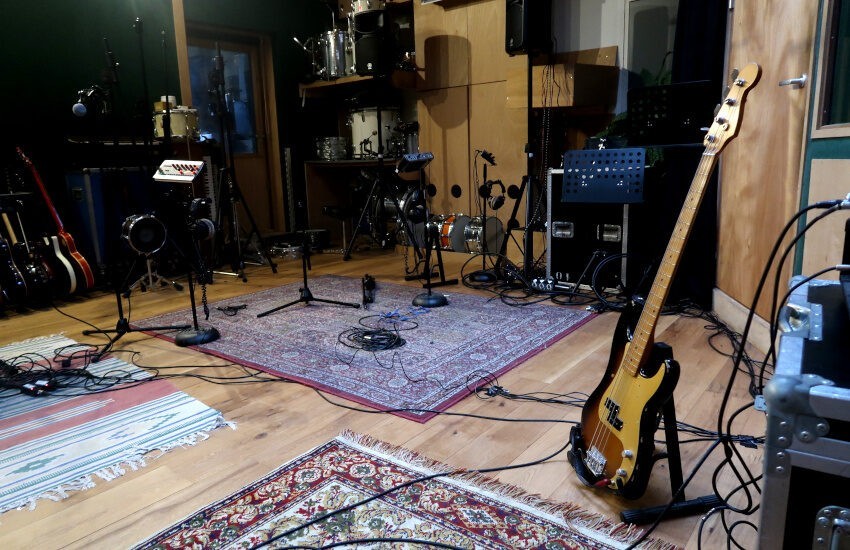This is the third article in a series that focusses on helping you write better basslines by giving you real life examples of basslines in a song context. This article features a transcription in bass tablature and standard notation as well as a breakdown why the bassline works. If you want to learn more about my philosophy behind writing good bass parts, be sure to check out my article How to write better basslines: The 4 ingredients.
You can find the other grooves that belong to this series by clicking on “Groove Backpack” in the top menu on this page, or by clicking here.
The groove
Harmony: the chord progression
This groove consists of two parts. The first part is a II-V progression. They are very common especially in Jazz Music. Famous examples of this chord progression in more popular music are for example Sunday Morning by Maroon 5 or The Ghetto by Donny Hathaway. Because the key of this composition is C, the chords are D minor and G major.
In the B part things get a bit more interesting harmony wise as you can see in the transcription below. Notice that although you would expect the A chord to be minor, the piano plays an A7 in the second bar of the B section. Before we return back to the A section, the keys play an A7sus4 and an A7. This choice is made often by players to lead to a certain chord. By giving a chord a dominant function, just like when the V-chord normally leads back to the I-chord, you feel you ear wants to resolve to the tonic. If you want to learn more about secondary dominants, click here.
It’s a good idea to figure out which mode/what scale you can play over the chords in the composition. In the key of C major the chords and it’s corresponding modes are:
| Roman Numeral | Chords | Mode |
| I | C | Ionian |
| II | Dmi | Dorian |
| III | Emi | Phrygian |
| IV | F | Lydian |
| V | G | Mixolydian |
| VI | Ami | Aeolian |
| VII | Bmi(b5) | Locrian |
Why the bassline works

The notes I play over the D minor chord are all available in the minor petatonic scale. Also these note are part of the D Dorian mode. On the G7 chord I only play the root note and the octave. This works over every chord.
Notice rhythmically I only connect with the kick drum on the first beat of every bar. Because the drummer is playing a kick drum on every downbeat (a.k.a. keeping it simple), it allows me to play off the kick drum like this, You don’t have to be exactly on the kick drum all the time, but notice that if you aren’t, the groove feels totally different than when you are.
The B-section

In the B-section I stick more to the kick drum on the first beat and the 16th before the third beat. By accentuating this together with the kick drum and the keys, it becomes more heavy and pronounced.
I use mostly roots and fifths over this section and I’m really aware of my note length. At the end of measure 8 I play a little walking line. The notes are derived from the Phrygian mode. In measure 11 I accentuate the harmony by first playing the D on the 7th note of the G string and then the C#. This is the sus4 resolving to the major chord. Notice I let some notes ring while others are being played.
Download and more grooves
If you want to download the whole transcription as a pdf, you can click here.
Be sure to check out the rest of the free series via:
https://bassessentials.com/category/free-bass-lessons-online/how-to-write-basslines-groove-backpack/
Subscribe for new grooves
Do you enjoy Groove Backpack? You can subscribe using the form below to get notifications as soon as new grooves are available.
I hope you found this article helpful! Let me know in the comments what your thoughts are and if you have any questions or suggestions.

